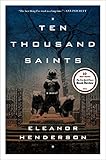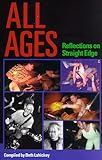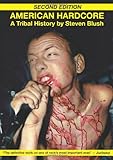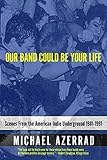 Eleanor Henderson’s debut novel, Ten Thousand Saints, follows a group of teenagers between New York City and Vermont as they do drugs, give up drugs, form bands, get pregnant, fall in love, and alternately avoid and seek out their parents. Confronting the adult world that awaits is rarely a graceful process for adolescents, and Henderson’s novel recalls all the sweat and fury of coming of age for anyone who dove into a mosh pit, or just fell for somebody who did. It’s also a beautifully rendered study of devotion—to a cause, a religion, a scene, and one’s own family—and all the conflict and sacrifice that devotion entails. The book was recently featured on the cover of the New York Times Book Review, where Stacy D’Erasmo wrote that Henderson “writes the hell out of every moment, every scene, every perspective, every fleeting impression, every impulse and desire and bit of emotional detritus.” I spoke with Henderson by phone about youth, gay marriage, the straight-edge scene today, and how many young people continue to wear Misfits jackets.
Eleanor Henderson’s debut novel, Ten Thousand Saints, follows a group of teenagers between New York City and Vermont as they do drugs, give up drugs, form bands, get pregnant, fall in love, and alternately avoid and seek out their parents. Confronting the adult world that awaits is rarely a graceful process for adolescents, and Henderson’s novel recalls all the sweat and fury of coming of age for anyone who dove into a mosh pit, or just fell for somebody who did. It’s also a beautifully rendered study of devotion—to a cause, a religion, a scene, and one’s own family—and all the conflict and sacrifice that devotion entails. The book was recently featured on the cover of the New York Times Book Review, where Stacy D’Erasmo wrote that Henderson “writes the hell out of every moment, every scene, every perspective, every fleeting impression, every impulse and desire and bit of emotional detritus.” I spoke with Henderson by phone about youth, gay marriage, the straight-edge scene today, and how many young people continue to wear Misfits jackets.
The Millions: Can you start off by talking a little about the process of writing this book? How much time did it take you? How close is the finished product to the idea you started with?
Eleanor Henderson: I started the book in 2001 when I was living in New York, and it took me about nine years to finish it. So it was a long, deliberate, painstaking process. I wasn’t writing every day for those nine years, but it was a project I was living with for those nine years.
The final draft is very different from the one I produced at University of Virginia. I began writing the book in graduate school and the first draft was 540 pages and it was all in Jude’s point of view. So it was incredibly long and messy but incredibly claustrophobic. And I realized I was limited by Jude’s perspective and really needed to open it up to other voices. So the biggest change the book underwent is it grew in scope, even as the pages shrunk. It now includes eight points of view. Over that process I realized it wasn’t one voice coming of age but a book about a whole generation coming of age. So that was the biggest transformation the book went through.


 TM: You mentioned in an interview with the Times that your husband grew up on St. Marks Place in the time period the book takes place, but I noticed in the acknowledgments you have a pretty serious list of books you consulted (Our Band Could Be Your Life, American Hardcore: A Tribal History, All Ages: Reflections on Straight Edge). What is your process of doing research for your writing? Do you do all the research first, and then write, or do research as you are writing?
TM: You mentioned in an interview with the Times that your husband grew up on St. Marks Place in the time period the book takes place, but I noticed in the acknowledgments you have a pretty serious list of books you consulted (Our Band Could Be Your Life, American Hardcore: A Tribal History, All Ages: Reflections on Straight Edge). What is your process of doing research for your writing? Do you do all the research first, and then write, or do research as you are writing?
EH: I do research as I’m writing. My husband’s experience definitely planted the seed for the book. It’s not based on his life, but based on the world he lived in and grew up in. He certainly was my number one source of information for that period and the bands and the setting, but I wanted to make sure I presented as full a world as possible of that time and place but also the straight edge scene in general. It’s a pretty intense little group of participants so I wanted to honor that history.
As I was writing the middle of the book, which is more boy-band focused, I probably spent more time at that point reading about the history of the bands. Something I found was that the anthologized zines that were written in that period really helped me listen to the voices of the kids that were producing these zines, helped me hear the syntax of these kids and the voices that were coming through. So the books helped but I certainly couldn’t have done it just based on the books.
TM: Are there fiction books you read as well, for inspiration, other novels that take place in the period or deal with similar themes?

 EH: I didn’t go out of my way to read books that were about the same period or subject but two books that were on my mind as I was writing were Michael Chabon’s Amazing Adventures of Kavalier and Clay and Jonathan Lethem’s The Fortress of Solitude. I really love those two books because they capture an era in New York that was all about teenage boys sort of making trouble and trying to do good at the same time and really kind of representing a larger cultural movement in an intensely personal way. And the language of the books and their stylistic accomplishment was really admirable to me. I asked myself, what kind of book do I want to write? I wanted to write a book that’s extremely detailed but also wide in scope.
EH: I didn’t go out of my way to read books that were about the same period or subject but two books that were on my mind as I was writing were Michael Chabon’s Amazing Adventures of Kavalier and Clay and Jonathan Lethem’s The Fortress of Solitude. I really love those two books because they capture an era in New York that was all about teenage boys sort of making trouble and trying to do good at the same time and really kind of representing a larger cultural movement in an intensely personal way. And the language of the books and their stylistic accomplishment was really admirable to me. I asked myself, what kind of book do I want to write? I wanted to write a book that’s extremely detailed but also wide in scope.
TM: When I heard last month about gay marriage passing in New York, after I thought about my real friends and family for whom this could be life-changing, I thought about Johnny, and how his story might have been different if he’d been born ten or twenty years later. Did you encounter any limitations about writing about the late 80s, things you wished the characters could do if the book took place today? Are there elements of the story that wouldn’t have worked in a different time?
EH: I didn’t feel limited by the time period. I still find it so fascinating that just 20 years ago we were living in a much more closeted age. I read a statistic the other day that one out of every two or even more college educated gay people are still closeted at work. So it’s not that everything turned around. But I do think it’s remarkable how much has changed, not only the way the city works but the openness of the city and, you know, the freedom of lifestyle that the city now affords in a way that wasn’t possible 20 years ago. So I thought about Johnny, too, in a bittersweet way because I think he does, as he heads to California [at the end of the novel], achieve his own kind of liberation. But I don’t think his adolescence would have been as dark or as tortured as it was. But he’s just one character, and there were certainly people who weren’t as closeted. For instance I had an uncle who likely contracted HIV in Central Park in the ‘80s, as Johnny’s partner Rooster does. He was living an openly gay lifestyle, but it killed him. It isn’t just that we’re more open but we’re also a safer, more aware culture. So that’s relieving to me and exciting to me but it’s really kind of bittersweet that not even a generation ago people were paying the price for their openness.
TM: In an interview for the New York Times Book Review you mention that the straight-edge movement is still going strong today.
EH: Yes. Many of the people I talk to about the book a) haven’t heard of straight edge and b) don’t know it’s still around. I chose to write about the late 80s because it’s full of an energy that hasn’t been captured before. Straight edge began in the early 80s and exploded all over the world. There are straight edge scenes that are much more developed in Europe than here in the States. Straight edge is thriving and I think it’s great. There are many faces to the movement, more and more sociological studies are coming about straight edge even though it’s an underground scene. There are straight edge kids who are into environmental activism, who are into animal rights, there are straight edge kids who may have romantic relationships but they don’t take any substances. And I think maybe more you’ll see more straight edge kids who haven’t had the kind of dark experiences with substances that Jude and his generation had and it’s easier for them to choose the straight edge lifestyle than it was for my husband, who grew up around such a mighty offering of drugs. So I think it’s changing a lot in a healthy way, but I think it still has its limitations. I don’t identify with straight edge, I never did. Although I love punk music, I sort of came of age a few years later during the grunge scene. I think I was drawn to the intensity of the music and the scene and the way these boys connected to each other in the 80s. I think it’s still happening now but maybe with a little less authenticity. Because I wasn’t a part of that tough little crowd I wanted to explore what it might have been like for a character who was.
TM: The ending is sort of tragic, heartbreaking. There’s a CBGB’s gift shop but no CBGB’s. Even during my punk phase in high school, I was buying my Manic Panic and band t-shirts at Hot Topic at the mall. Do you think there are authentic, unmediated subcultures left for young people to find their identities within?
EH: That’s a good question. I don’t know. I teach at Ithaca College and I see a fair amount of punk-minded students coming in with Misfits jackets, and they’re adorable and in a way maybe they’re more connected than we are, because we’re just a little bit removed from them. I don’t know if they’re buying their shirts at Hot Topic but what else is there? I don’t know if there are any alternatives. It’s hard for me to imagine a post-punk, authentic music movement. Maybe that’s just the grandmother in me talking about the good old days, but even when I came of age in the 90s, sitting in these enormous stadiums watching the Stone Temple Pilots, I felt an age had passed.
TM: I’m so out of touch with music today I’m probably not the best judge of what’s authentic but music does seem to be so commodified and digitized it’s hard to have the direct relationship with music that straight edge kids did.
EH: This is sort of a tangent but I was talking the other day about reading books on Kindle and listening to music on iPods and I’m still sort of the grandmother who is listening to CDs. But you hear a lot of people saying they love to hold the weight of book in their hands, love the cover art on CDs… One of the things I admire about my 3-year old is he’ll always have in hand the case of whatever video he’s watching along with his Batman doll. He wants to look at the cover art and see the pictures. These boys [in the novel] as they were producing their own records and pressing their own records and designing the zines about these records, that’s an intimacy with their own culture that we’ve gone a long way away from. We have very little connection to the actual source of our art these days.
TM: Why do you think punk continues to endure whereas the music of, say, the hippie generation doesn’t?
EH: Yeah, maybe that’s true. There is an energy from punk music that is inimitable and I wanted to capture some of that energy in the book. It’s irresistible, it’s so explosive culturally and just on the stereo. I don’t think it’s a coincidence that every Prius commercial is orchestrated to “Blitzkrieg Bop” or whatever. There is something really enduring about punk and something really classic about its, you know, its rites of rebellion. Because you know this generation, the hippie generation thought that they perfected rebellion. And they did, in a way, which required a lot of creativity for the kids of the 80s to reinvent their own kind of rebellion. So it was fascinating for me to see this very backwards sect of rebellion. Punk just turned its hippie forbearers on their heads.
TM: Are you a fan of The Wire? Did you hear that David Simon agreed to make a sixth season of The Wire if “the Department of Justice is equally ready to reconsider and address its continuing prosecution of our misguided, destructive and dehumanising drug prohibition.” Do you agree with his characterization of the War on Drugs?
EH: I don’t know that the book is a statement of the failure of the war on drugs, although it sort of alludes to it and tries to capture the complexity of it. I don’t know that the book is richly concerned with the war on drugs but I do think the book is concerned with showcasing side-effects of the war on drugs, particularly with the gentrification of the Lower East Side. The Lower East Side is a much safer place to exist because there aren’t a bunch of needles in Tompkins Square Park anymore. But the costs of that were pretty violent.
I’m interested in the choices that the Just Say No generation made in the face of that war on drugs. And these kids are really embracing it in a way that their hippie parents cringe at. So I guess the social implications are more interesting to me.
TM: Your author bio says you teach. Do you find that teaching has an effect on your writing practice?
EH: Yeah, I mean so obviously the fact that I’ve been teaching full-time probably has something to do with the book taking nine years to write.
I really find that teaching complements my writing. It makes it more difficult on a practical level but it fuels my writing. The conversations I have with my students about craft are things I think about when I sit down. Having to formulate conversations about craft with young writers can only make you a stronger and more self-aware writer. I love having conversations with my students. I’ve been at Ithaca College for a year and feel really lucky to have landed in the right place.








